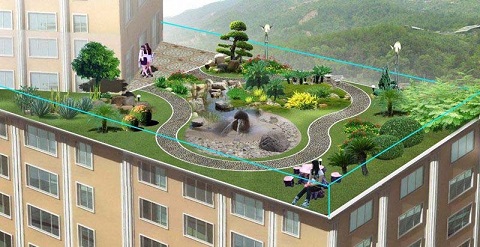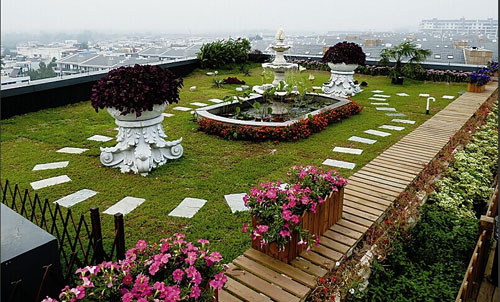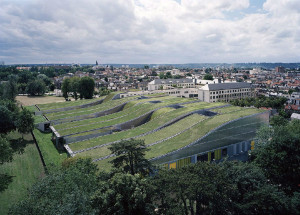Sky Garden breaks through ordinary imagination
Shanghai’s Most “Exotic” Commercial Building: Sky Garden Breaks Through Ordinary Imagination

⬆ Recommended: HT-508 Green Roof Module | Adjustable Water Retention and Drainage
Do you remember the “Babylon Sky Garden” that was featured in foreign media reports about Shanghai even before its completion two years ago? Dubbed “suspicious,” “magical,” and criticized for not considering maintenance costs, its unique tree-covered roof design made it one of the most controversial landmarks in Shanghai.
After eight years, the building, now officially named “1000 Trees,” is nearing completion. Recently, while passing the Suzhou River in Shanghai, I noticed the scaffolding had been removed, revealing this “magical” structure along the riverside.
▲ @ Qingyan Zhu
In photos, it looks quite astonishing. From a distance, it resembles a rolling mountain.
▲ Photo source: Tianan Qianshu Public Account
Up close, it appears like an oasis floating on the river.
▲ @ Qingyan Zhu
Located near Shanghai’s renowned creative park M50, the exterior fence of 1000 Trees is adorned with graffiti walls, adding an artistic touch to its magical landscape. It is set to open to the public next year.
400 Steps, 1000 Trees: A Controversial Magical Landmark
The “1000 Trees Sky Garden” project, also known as “Tianan Qianshu,” is situated in a bustling city area near the Shanghai Railway Station and just 4-5 kilometers from the Bund and Xintiandi.
Positioned along the Suzhou River, it boasts a 900-meter-long riverfront walkway. Coupled with the nearby historic IP Rong’s building, it creates a fascinating blend of old and new.
▲ @ Qingyan Zhu
The western building is nearly complete, standing out with its distinctive and prominent geometric trapezoidal shape that mimics the height of a jungle walk, giving it a streamlined beauty. The shape appears different from every angle.
The north facade features a terrace formed by 400 steps and 1,000 pure white tree-shaped pedestals.
▲ @ Qingyan Zhu
About 25,000 plants, including shrubs, perennials, and climbing plants, were planted on the roof and the top of the pillars on the facade. The stack of terraces and trees resembles a rolling hill, adding layers and vitality to the building.
The perspective shifts to the south elevation, where it becomes flat. Viewed from a height, it appears as if a large “mountain” has been cut in half.
To better integrate 1000 Trees into the M50 art area, the architectural firm invited graffiti artists to create murals on the south high wall. The architectural modeling itself is strong, and the painted cut-off “mountain body” adds an element of mystery.
Despite its stunning appearance, many find 1000 Trees difficult to accept, considering it weird and out of place among surrounding high-rise buildings. Concerns about exposed columns and maintenance costs remain hot topics.
▲ 1000 Trees real picture, @Qingyan Zhu
Despite the controversy, in an era of ubiquitous high-rise buildings, 1000 Trees stands out for its imaginative design and valuable attempt to break the norm.
Designed by the World’s Hottest Architect, Inspired by Chinese Landscape Painting
The mastermind behind this aerial forest in a city of steel and cement is Thomas Heatherwick, a world-renowned architect. Known as the “Leonardo Da Vinci” of the 21st century, Thomas has won prestigious awards like the Royal Industrial Design Medal and the Architectural Award-“Prince Philip Award.”
At 39, Thomas defeated famed architect Zaha Hadid to win the design rights for the British Pavilion at the 2010 Shanghai World Expo.
▲ The British Pavilion at Shanghai World Expo
His iconic works include the Hudson City Square in New York and the main torch stand (204 copper petals) for the London Olympics, making him one of the world’s most sought-after architects.
▲ Hudson City Plaza, New York
Unlike ordinary architects, Thomas’s designs often transcend the conventional boundaries of architecture, filled with rich imagination and creativity. To design 1000 Trees, he personally visited Suzhou, drawing inspiration from its gardens and Chinese paintings, reflecting the relationship between Chinese civilization and architecture in the project.
▲ It has the charm of Suzhou gardens
Thomas admits that 1000 Trees is his biggest project inspired by Chinese elements. He hopes that this building will allow people to experience the joy of urban exploration. “The mountain garden was conceived not as a building, but as part of nature.”
▲ The 1000 Trees architectural model shows the design idea of anti-packaging box
In this “garden building” filled with 1,000 trees, the pillars protrude from the ceiling like tree trunks, with “flower pots” at the top resembling branches. The surface details of the pillars feature undulating corrugated designs, mimicking layered rocks in nature.
Despite being planted in reinforced concrete, the trees are well-supported. The project includes a modern planting system with advanced arbor fixing, automatic drip irrigation, and rain sensing integration, ensuring the soil near the roots remains moist.
Beyond its stunning appearance, 1000 Trees helps mitigate the greenhouse effect, reduce noise, dust, and harmful air, improve the surrounding ecological environment, and save energy.
Shopping, Exhibitions, and Riverside Walks: A New Attraction in Shanghai
Currently, only the western area of the project is nearing completion. Thomas describes it as “two mountains covered with green vegetation,” divided into east and west areas. The total construction area is approximately 278,500 square meters, with commercial, apartment hotels, and office buildings in the east and commercial and entertainment centers in the west.
The second “mountain” in the east, still in planning, will be larger and more diverse in design. A closed bridge and tunnel will connect the two “mountains,” offering an interesting experience for visitors.
In addition to shopping, 1000 Trees will feature extensive landscaping projects, including 900 meters of riverside public space and a 12,000-square-meter landscape park with jogging paths, sculpture gardens, and outdoor activity spaces, attracting nearby residents for fitness and leisure.
A Must-Visit Attraction
1000 Trees is also adjacent to Moganshan Road, surrounded by fashionable and creative streets, the Changhua Road yacht dock, M50, and the Jade Buddha Temple, making it a must-visit spot for visitors.


































